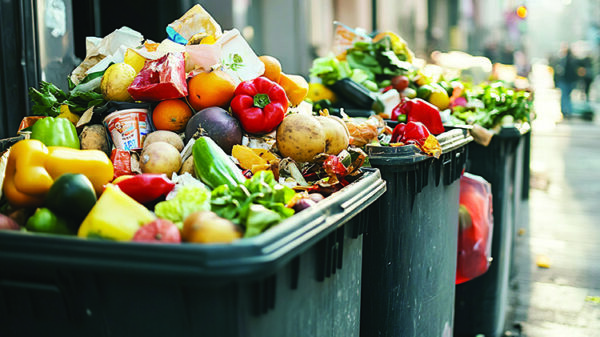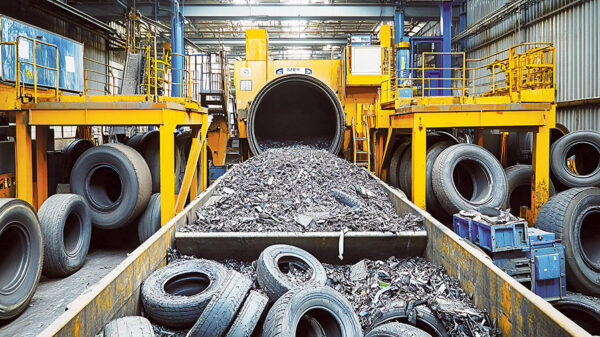Never underestimate the power of incorporating new technology into well-established processes. The new generation of high technology solutions gracing the waste and recycling industries has taken hold – impacting industry players and consumers in ways never imagined.
Christopher Beaufait is president and chief executive officer of Heartland, a leading waste solutions provider. Heartland utilizes patented, cutting-edge systems that eliminate the “forever chemical” PFAS, reducing the waste volume by as much as 95 percent and, when necessary, delivering 100 percent assured PFAS destruction. In addition, the company is successfully converting food waste into turquoise hydrogen and ultra-pure synthesis gas, used to produce clean energy, reducing landfill mass, our reliance on foreign oil and our impact on climate change.
“Numerous technological innovations are reshaping the [waste] industry, but the ability to integrate advanced solutions ‘at the source’ is among the most transformative,” Beaufait said. “These solutions enable customers to process waste where it is generated, reducing transportation costs and emissions while scaling alongside increasing waste volumes. This flexibility and efficiency demonstrate how advanced technologies can empower the industry to solve today’s most pressing environmental and societal challenges.”
As Beaufait pointed out, the waste industry has seen significant evolution in efficiency, resource recovery and environmental sustainability, driven by key technological advancements.
For example, Heartland’s HelioStorm system embodies this shift with its compact footprint and modular scalability. It brings ultra-high temperature ionic reforming capabilities directly to waste removal sites. Here it can achieve plasma field temperatures between 3,000 and 10,000°C, allowing it to destroy persistent contaminants like PFAS and convert food waste, plastics and biosolids into high-value energy products, including turquoise hydrogen and ultra-pure syngas.
“Advanced technologies are transforming waste handling, making the work of waste solutions providers far more impactful than ever before,” Beaufait says. “Robotics and automation are reshaping the industry, driving improvements in precision, safety and cost-efficiency.”
The AI Revolution in Waste
Consider this – only 5 percent of plastic is recycled today in the U.S. One of the drivers of that massive problem is extremely low recycling efficiency within recycling facilities – where recyclable materials fall through the cracks and end up in landfills. Manual sorting, and the lack thereof, is one major reason for that. Only 1 percent of waste is monitored in facilities, and even in advanced economies, 40 percent of waste sorting is done by hand.
Greyparrot solves this problem with an AI-powered waste analyzer that is installed above waste streams within recycling facilities to identify materials in milliseconds, and then provides each item’s data on 89 waste categories across seven layers, including financial value, brand, and GHG emissions to improve environmental-friendly recycling of each item.
However, in addition to AI-led sorting, this technology is also helping recycling facilities improve their efficiency facility-wide. For instance, according to Gaspard Duthilleul, chief operating officer of Greyparrot, AI waste identification can pinpoint the cause of waste stream blockages to eliminate downtime: As an example, waste composition data of waste obtained by AI waste identification can reveal that the volume of paper often spikes before a blockage. Operators can use that insight to isolate paper-sorting machinery for inspection. This type of data-assisted, proactive maintenance is crucial in avoiding costly downtime and extending the life of machinery, ensuring that the recycling process remains efficient and uninterrupted.
“The most significant tech developments in the last five to six years have been robotics (automation) and AI,” Duthilleul said. “Around 2019, robotics really took off in the waste industry. It was the main topic at every industry event that year, just as AI has been the topic du jour at every event over the last year.”
At the time, it was only one year since China banned imports of waste from the Western world, and the industry was looking for radical solutions to address a disrupted market. As Duthilleul pointed out, the focus became further automating the sorting and separation process at waste facilities with robots. This was the latest in years of continuous shifts away from manual to automated sorting solutions.
“MRFs worldwide quickly jumped on the robotics bandwagon to help address the soaring cost of recycling with automation and improve the purity of recyclables to boost revenue. The problem at the time was that many of these facilities were flying blind when they decided to implement robots, with little data on their waste streams to actually influence where and what type of robots they should integrate, if any,” Duthilleul said. “The result was that some of the largest waste management companies in the world bought hundreds of robots and soon found that they weren’t achieving the desired results.”
However, Duthilleul said robotics and automation have really got “a shot in the arm” in the last year or two from AI as the use of computer vision, object detection models, and machine learning has uncovered the industry’s blind spot to provide waste data and intelligence on almost every waste material.
“With 100 percent visibility, waste facilities can now truly understand the composition of their waste streams,” Duthilleul said. “It’s really changed the game in terms of how we understand and manage waste flows – allowing for more efficient sorting, contamination tracking, and recovery optimization in real time. Furthermore, AI-obtained waste intelligence is now serving as a roadmap for implementing waste robots that maximize ROI and minimize the amount of time it takes for robotics payback.”
AI can also improve the purity of recycling bales: By accessing purity data in real-time from AI sensors, facility managers can spot and adapt to trends faster rather than waiting on intermittent manual samples. Even a small drop in purity – from 99 percent to 95 percent – can jeopardize customer contracts. Greyparrot recently saw a case where a facility faced such a drop but leveraged real-time data to resolve the issue in minutes instead of days. They ultimately saved about $65,000 by avoiding the need to reprocess 40 tons of aluminum cans.
“With the combined power of AI and automation, waste facilities, and more broadly, the waste industry as a whole can move to holistic plant optimization solutions with AI at the center of them,” Duthilleul said. “We’re seeing waste facilities use this AI-first approach to detect blockages and reduce downtime. In other areas, AI-powered data solutions offer significant cost efficiencies. Consider sampling costs: manual sampling of 4.6 tons of PET typically costs around $3,500, while AI-driven sampling reduces this to approximately $6.25.”
Indeed, America’s largest waste management organizations are now using automation to improve recycled product quality and navigate unstable commodity prices. And in Northern Ireland, AI and robotics have so dramatically improved sorting efficiency that waste professionals now advocate for simpler three-bin systems rather than more complex alternatives.
“So, this is much more than just a change of sorting and handling techniques,” Duthilleul said. “We’re seeing AI and automation unlock lean operations for waste and recycling facilities, enabling them to pinpoint waste stream blockage causes, transition from weekly manual sampling to real-time purity data use, and stabilizing throughput to minimize residue losses.”
Future Advancements
Heartland’s projections over the next decade include: 9 million tons of averted CO₂; 11 million tons or approximately 3.3 billion gallons of renewable fuel generation, including methanol and sustainable aviation fuel (SAF); 16 million tons of plastic waste redirected from landfills’; 37 million tons of biosolids containing the “forever chemical” PFAS destroyed; an avoidance of 51 million trucking miles, which reduce emissions through localized waste handling; and 9 billion gallons of wastewater treated.
“We believe high-tech integration will fundamentally reshape the waste industry by enabling new solutions, improving sustainability and unlocking economic value,” said Beaufait, who pointed to three key trends that stand out:
- Renewable fuels at market-competitive prices: Policies aimed at reducing energy costs, such as those being introduced by the Trump administration, which provide a favorable environment for renewable fuel development. Heartland is leveraging this opportunity to produce market-competitive bio-methanol, sustainable aviation fuel (SAF) and turquoise hydrogen, paving the way for a cleaner, more sustainable energy economy.
- Transforming waste into energy-rich resources: By converting plastics, food waste and biosolids into high-value energy products, Heartland supports the circular economy, reducing landfill dependency and creating new revenue streams for its partners.
- Evolving the partnership model: The future lies in fostering partnerships based on a stakeholder model that benefits customers, society and the economy – a “win-win-win” approach. Prioritizing collaboration with municipalities, private enterprises and public agencies will help scale innovative solutions and create long-term value.
“Looking forward, the continued integration of advanced technologies such as AI for predictive analytics, automated waste-to-energy facilities and expanded public-private partnerships will unlock the full potential of waste as a resource,” Beaufait said.
For Duthilleul and the team at Greyparrot, the future of waste management technology looks pretty exciting. As he explained, the industry is moving toward creating a standardized digital infrastructure that will track materials throughout their entire journey – from collection through processing and into new products. Duthilleul expects AI systems will play a massive role with the dynamic control and smarter material recovery facilities that take us to the next stage of optimization. Facility operators will be able to adjust and optimize operations in real time based on changing waste flow conditions to maximize recycling efficiency and revenue.
“This technology is also going to be crucial for helping manufacturers and CPG brands design more recyclable packaging through better feedback loops,” Duthilleul said. “The ultimate goal is ambitious but certainly achievable: making recycling efficient and profitable enough to cut plastic pollution by 20 percent by 2040. With the recycling industry stepping up to fill the leadership void left by policymakers, technology is going to be at the heart of tackling our waste challenges.”
Published March 2025






